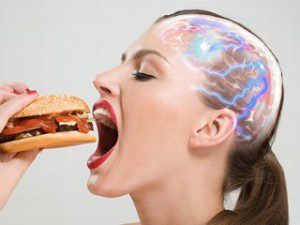Contributing Writer for Wake Up World
It’s not surprising that processed foods are designed to foster addictive behavior — robbing us of our health, serenity and hard-earned cash. Sugar, fat, salt and artificial flavors are manipulated in such a way that after one taste, consumers just cannot help themselves and a vicious cycle begins. Not only ingredients, but texture, shape and ‘mouth feel’ are all heavily researched and refined to create a highly pleasurable experience as well.
Even though the average American does not view junk food as an addiction, researchers have discovered unhealthy food can actually seize the brain in the same way nicotine, cocaine and other drugs do — leaving us at the mercy of cravings and binges.
Processed food – The devil is in the details
Picture for a moment two pieces of chocolate. Both have identical ingredients and are processed in the same manner except for one crucial difference: shape. One is square and the other round. The commercial food industry is betting the latter will be the chocolate of choice — hooking more repeat customers while selling a higher volume. Incredibly, the size and shape of chocolate is big business. For three years, Nestle studied the “detection mechanisms in the oral cavity” and “improving melt-in-mouth quality while simultaneously reserving enough space in the mouth for the aroma to enrich the sensorial experience,” according to their press release. In a nutshell, the round shape will bring greater pleasure and higher consumption rates while increasing corporate profits. And Nestle is just one instance. In the highly competitive field of processed and fast food, neuroscience has entered the scene to help create the most addictive, lucrative and sought-after junk food.
Consider “sensory-specific satiety.” Industry developers label this holy grail the ‘bliss point.’ The idea is where a food does does not completely satisfy, but is pleasurable enough to induce cravings. Michael Moss explains in the New York Times article, “The Extraordinary Science of Addictive Junk Food:”
“The biggest hits – be they Coca-Cola or Doritos – owe their success to complex formulas that pique the taste buds enough to be alluring but don’t have a distinct, overriding single flavor that tells the brain to stop eating.”
Interestingly, nicotine andnarcotic addictions hijack the brain in a similar fashion.
Irresistible allure of engineered edibles
Nora Volkow, director of the National Institute on Drug Abuse, believes there is a “tremendous overlap between drugs in the brain and food in the brain.” A good example is found with research at The Scripps Research Institute. The investigation showed “…the same molecular mechanisms that drive people into drug addiction are behind the compulsion to overeat, pushing people into obesity.” During the three year experiment, rats were fed either a nutritious diet or one that was extremely unhealthy yet very palatable. According to Associate Professor Paul J. Kenny:
“In the study, the animals completely lost control over their eating behavior, the primary hallmark of addiction. They continued to overeat even when they anticipated receiving electric shocks, highlighting just how motivated they were to consume the palatable food.”
Kenny continues, “what happens in addiction is lethally simple. The reward pathways in the brain have been so overstimulated that the system basically turns on itself, adapting to the new reality of addiction, whether its cocaine or cupcakes … These findings confirm what we and many others have suspected, that overconsumption of highly pleasurable food triggers addiction-like neuroadaptive responses in brain reward circuitries, driving the development of compulsive eating.”
Article Sources
Previous Articles By Carolanne
- This is Your Brain on NutraSweet – and it Isn’t Pretty
- DIY Natural Sports Drinks & Protein Bars
- Brew Up a Wealth of Healthful Benefit with Chai Tea
- Inspiring Urban Farm Grows an Astonishing Three Tons of Produce a Year on a Mere 1/10 of an Acre
- Discover the Seven Habits of Exceedingly Healthy People
- Enjoy the Surprisingly Sweet Health Benefits of Pure Maple Syrup
About the author:
I’m Carolanne — a writer, chef, traveler and enthusiastic advocate for sustainability, organics and joyful living. It’s good to have you here. If you would like to learn more, connect with me at Thrive-Living.net or visit Twitter.com/Thrive_Living.Please note this article was first published on Natural News.

If you've ever found value in our articles, we'd greatly appreciate your support by purchasing Mindful Meditation Techniques for Kids - A Practical Guide for Adults to Empower Kids with the Gift of Inner Peace and Resilience for Life.
In the spirit of mindfulness, we encourage you to choose the paperback version. Delve into its pages away from screen glare and notifications, allowing yourself to fully immerse in the transformative practices within. The physical book enriches the learning process and serves as a tangible commitment to mindfulness, easily shared among family and friends.
Over the past few years, Wake Up World has faced significant online censorship, impacting our financial ability to stay online. Instead of soliciting donations, we're exploring win-win solutions with our readers to remain financially viable. Moving into book publishing, we hope to secure ongoing funds to continue our mission. With over 8,500 articles published in the past 13 years, we are committed to keeping our content free and accessible to everyone, without resorting to a paywall.








